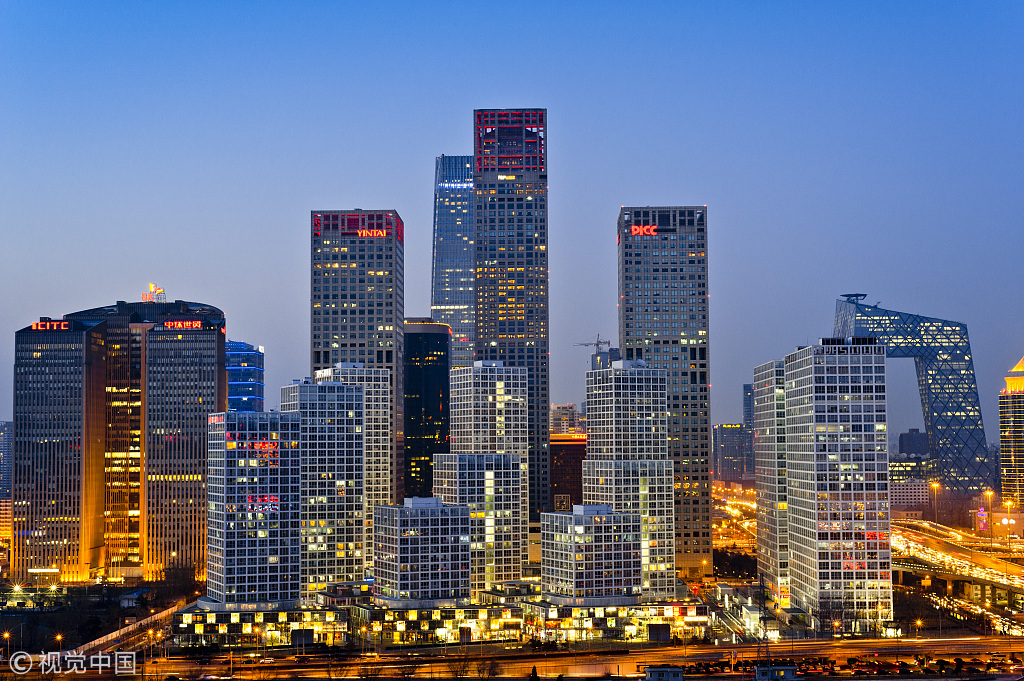The bright and not-so-bright spots of China's economy in 2018
By Bian Yongzu | chinadaily.com.cn | Updated: 2019-01-30 10:26

National Bureau of Statistics has announced the economic figures of China in 2018. According to preliminary calculations, the annual gross domestic product was 900,309 billion yuan, an increase of 6.6 percent over the previous year. In terms of industries, the added value of the primary industry was 64,734 billion yuan, an increase of 3.5 percent over the previous year; the added value of the secondary industry was 366,001 billion yuan, an increase of 5.8 percent; the added value of the tertiary industry was 469,575 billion yuan, an increase of 7.6 percent.
Some of the data is very encouraging. For example, the gross domestic product exceeded 90 trillion yuan for the first time. The initial estimate of per capita GDP was close to $10,000, and the so-called "middle income trap" was in sight. GDP grew by 6.6 percent year-on-year, exceeding expectations for the beginning of the year. In large economies, India's economic growth rate may slightly exceed that of China, but China's annual economic growth was equivalent to half of India's GDP, from which China's speed and China's weight can be felt.
More importantly, the sense of gains brought to the residents by economic growth has further increased. First, the per capita disposable income has risen. In 2018, the per capita disposable income of the national residents was 28,228 yuan, an increase of 8.7 percent over the previous year. After deducting the price factor, the actual increase was 6.5 percent. And the per capita disposable income of urban residents was 39,251 yuan, an increase of 7.8 percent. After deducting the price factor, the actual increase was 5.6 percent. The per capita disposable income of rural residents was 14,617 yuan, an increase of 8.8 percent. After deducting the price factor, the actual increase was 6.6 percent.
Second, the consumption expenditure of residents has increased. In 2018, the per capita consumption expenditure of the national residents was 19,853 yuan, an increase of 8.4 percent over the previous year. After deducting the price factor, the actual increase was 6.2 percent. And the per capita consumption expenditure of urban residents was 26,112 yuan, an increase of 6.8 percent. After deducting the price factor, the actual growth was 4.6 percent; the per capita consumption expenditure of rural residents was 12,124 yuan, an increase of 10.7 percent. After deducting the price factor, the actual increase was 8.4 percent.
Third, the consumption structure of residents has been improved. In 2018, the per capita consumption expenditure of the national residents was 19,853 yuan, an increase of 8.4 percent over the previous year. The per capita transportation and communication expenditure were 2,675 yuan, an increase of 7.1 percent, accounting for 13.5 percent of the per capita consumption expenditure. The per capita education, culture, entertainment and consumption expenditure was 2,226 yuan, an increase of 6.7 percent, accounting for 11.2 percent of the per capita consumption expenditure; the per capita health care consumption expenditure was 1,685 yuan, an increase of 16.1 percent, accounting for 8.5 percent of the per capita consumption expenditure. The growth rate of such expenditures exceeded the average.
In face of a complicated economic environment, such achievements were beyond expectations. However, under the encouraging data, we also need to pay attention to some concerns of the China’s economy.
First, with the intensification of trade friction between China and the United States, the contribution of trade to the economy changed from positive to negative. From January 7 to 9, China and the United States held consultations at the vice-ministerial level on economic and trade issues in Beijing. Although the details of the negotiations have not been disclosed too much, the rise of RMB exchange rate in recent days reflected that the market was optimistic about Sino-US trade negotiations. As the United States is also facing the pressure of economic slowdown, it is unlikely that the United States will continue to increase tariffs. Therefore, Sino-US trade frictions may ease in the short term. However, in the long run, some contradictions behind Sino-US economic and trade frictions have not disappeared, and trade friction factors deserve long-term attention.
Second, from the domestic situation perspective, domestic demand is facing severe challenges: First, the growth rate of infrastructure investment has declined. Under the background of strict investigation of local government “hidden debts”, local government financing is more difficult. Infrastructure investment thus continues to fall in the absence of financial support. Second, the credit expansion with low sustained growth has begun to affect corporate investment and financing activities and household consumption. The growth rate of M2 and social financing has continued to decline. The decline in credit expansion has affected the investment and financing activities of enterprises and the consumption needs of residents. The growth rate of social consumer goods sales in November 2018 hit a 15-year low. In addition, the problems of financing difficulties for private enterprises and small and micro enterprises are also more prominent.
The trend of high before low and gradual decline in the economy before 2018 also indicates that the economy will face more challenges this year. From the outside, Sino-US trade, Brexit, and the Fed's monetary policy are all likely to undergo unexpected changes. From the internal point of view, to maintain China's economic growth at an appropriate interval of the medium and high speed and to create a good environment for various reforms, the key is to boost social consumption demand and investment demand. Therefore, we must pay attention to both the supply side reform and the demand side reform. At the Central Economic Work Conference, we have proposed a series of policies to support economic growth, including actively using fiscal policies such as larger tax cuts so that companies can invest more funds, and moderately expanding the scale of local debt and accelerating the infrastructure to complement in the short term, which will actually play a role in China’s economic growth.
More importantly, it is becoming an increasingly urgent task to accelerate capital market reforms, boost investor confidence and allow more companies to obtain direct financing. In 2018, the capital market experienced a large irrational decline, which led to a significant decline in its financing function. The market value of listed companies generally shrank significantly, and some of the shareholders pledged stock burst, which not only affected the normal financing business of enterprises, but also caused a blow to household consumption. At present, China's A-share valuation is at an all-time low, and it obviously does not reflect the results of China's economic development. Therefore, the government's moderate intervention in the stock market is conducive to the recovery of its functions such as financing and wealth management, and is also conducive to reverse the downward trend of social investment and consumption.
In short, year 2019 is facing a more complicated development situation, but China still has sufficient policy space. We must maintain our efforts and continue to promote supply-side reforms. We must also attach great importance to moderately expanding aggregate demand. We must resolutely eliminate all restrictions in development and form a domestically unified and strong domestic demand market as soon as possible, which is exactly the great advantage of China's long-term stable economic.
The author is a research fellow of the Chongyang Institute for Financial Studies at Renmin University of China.
The opinions expressed here are those of the writer and do not necessarily represent the views of China Daily and China Daily website.
























